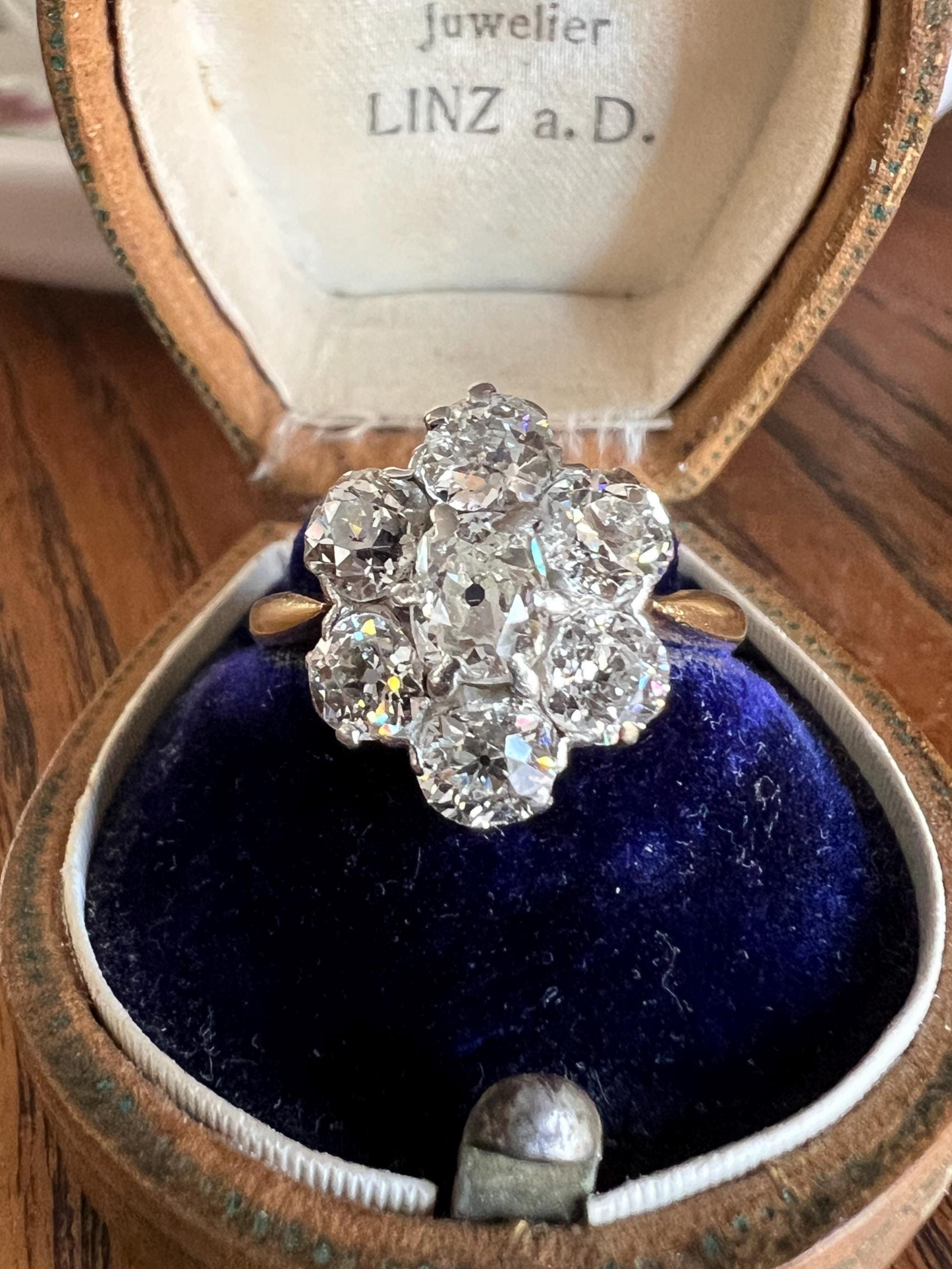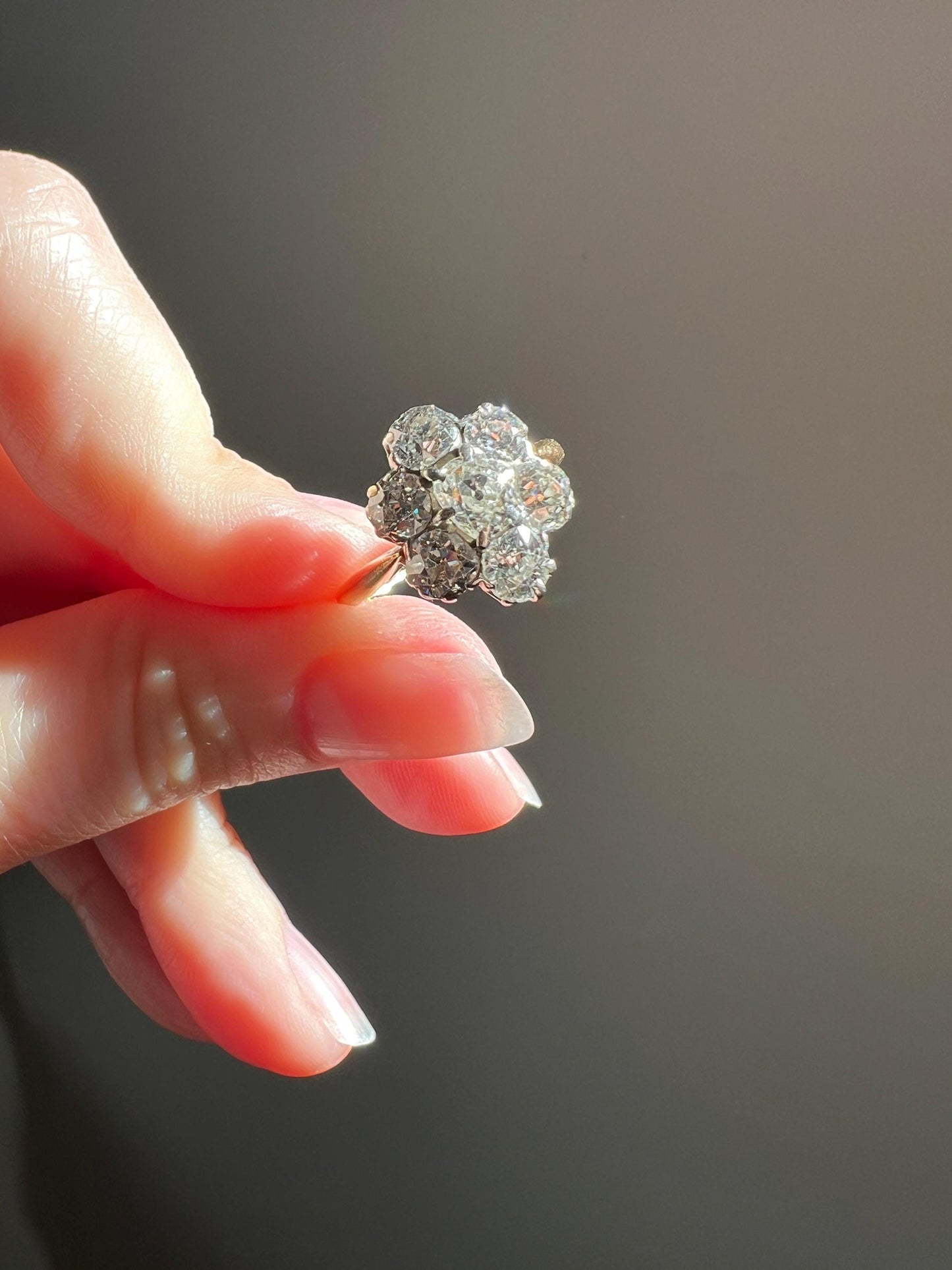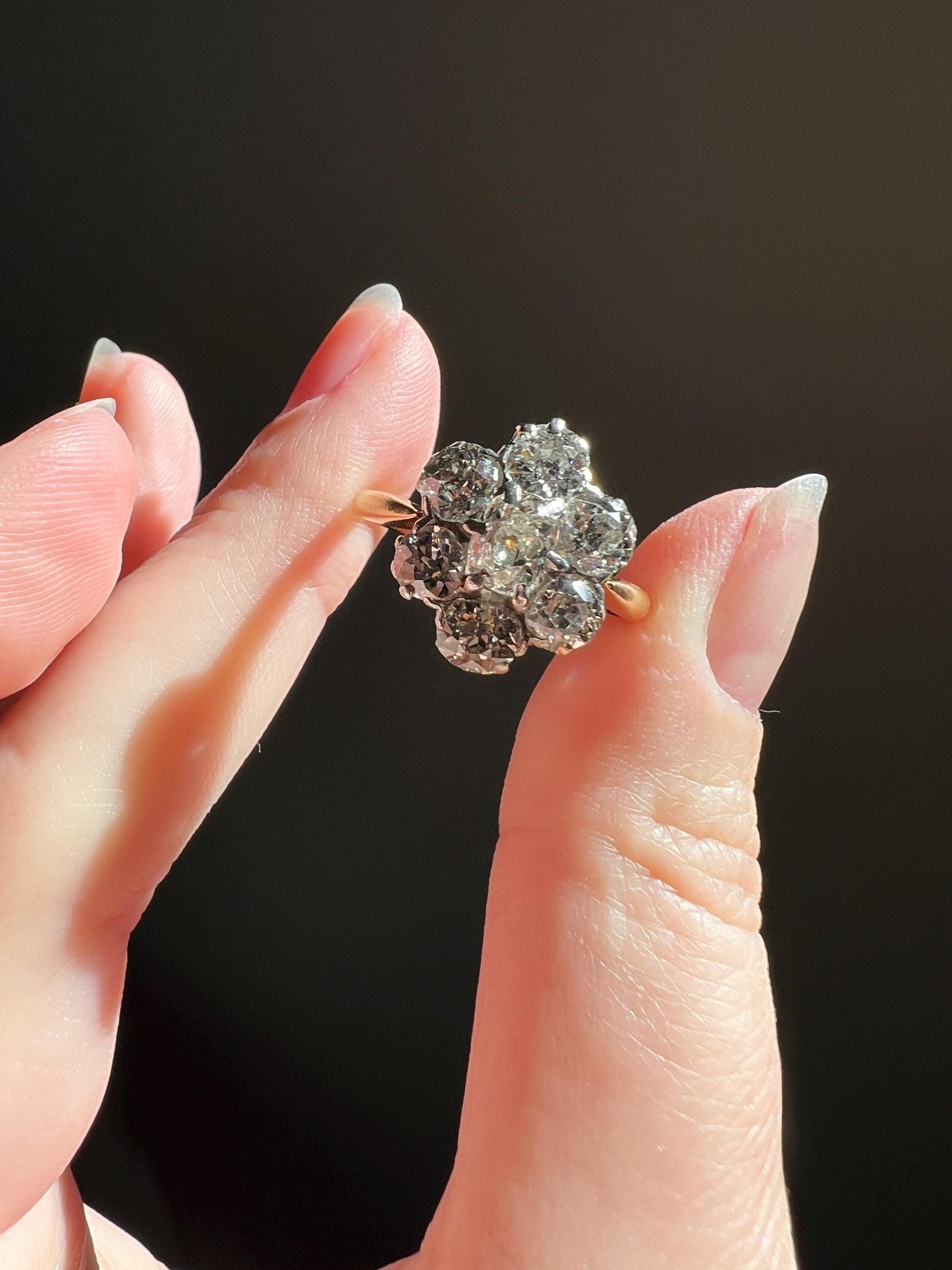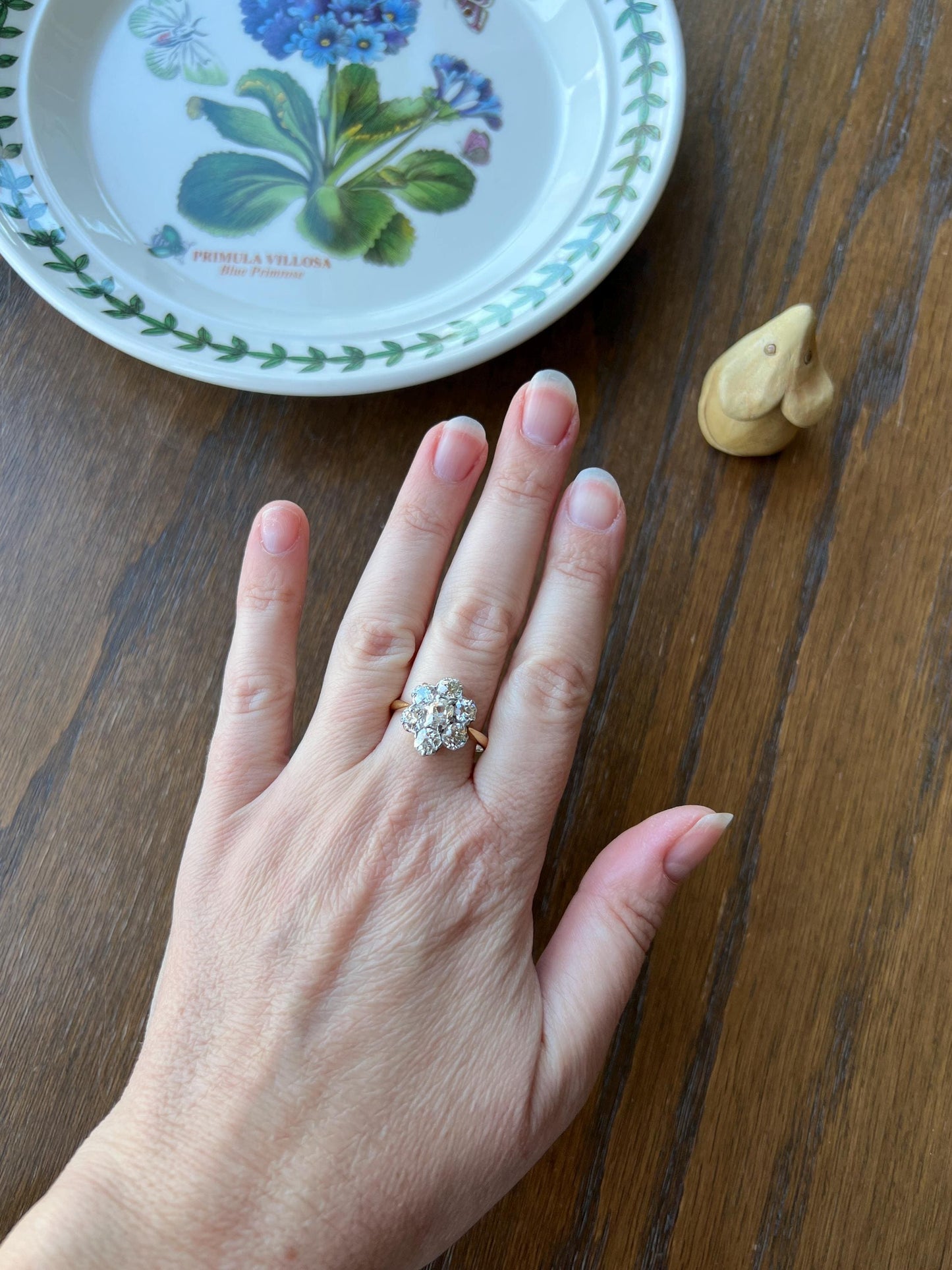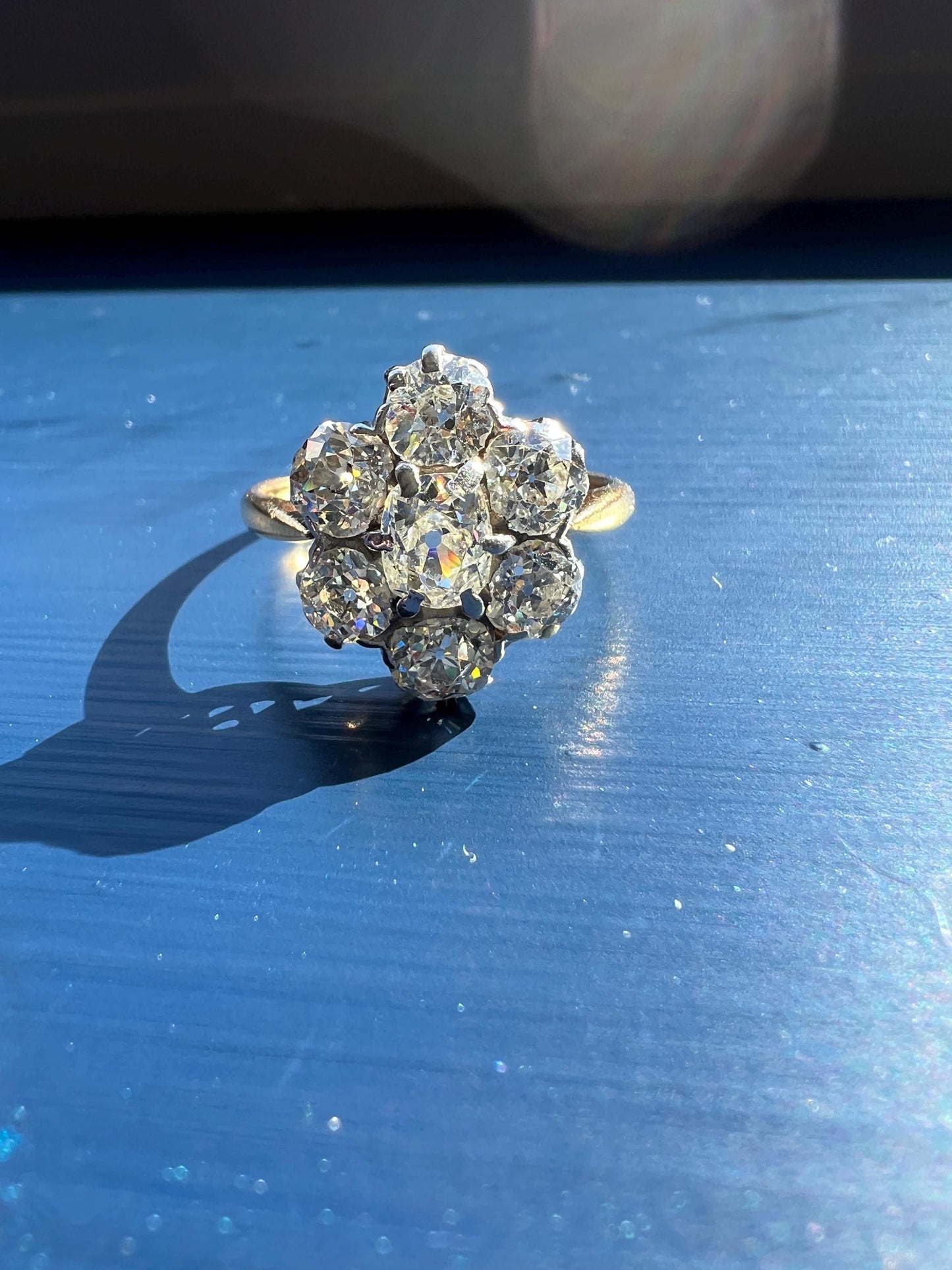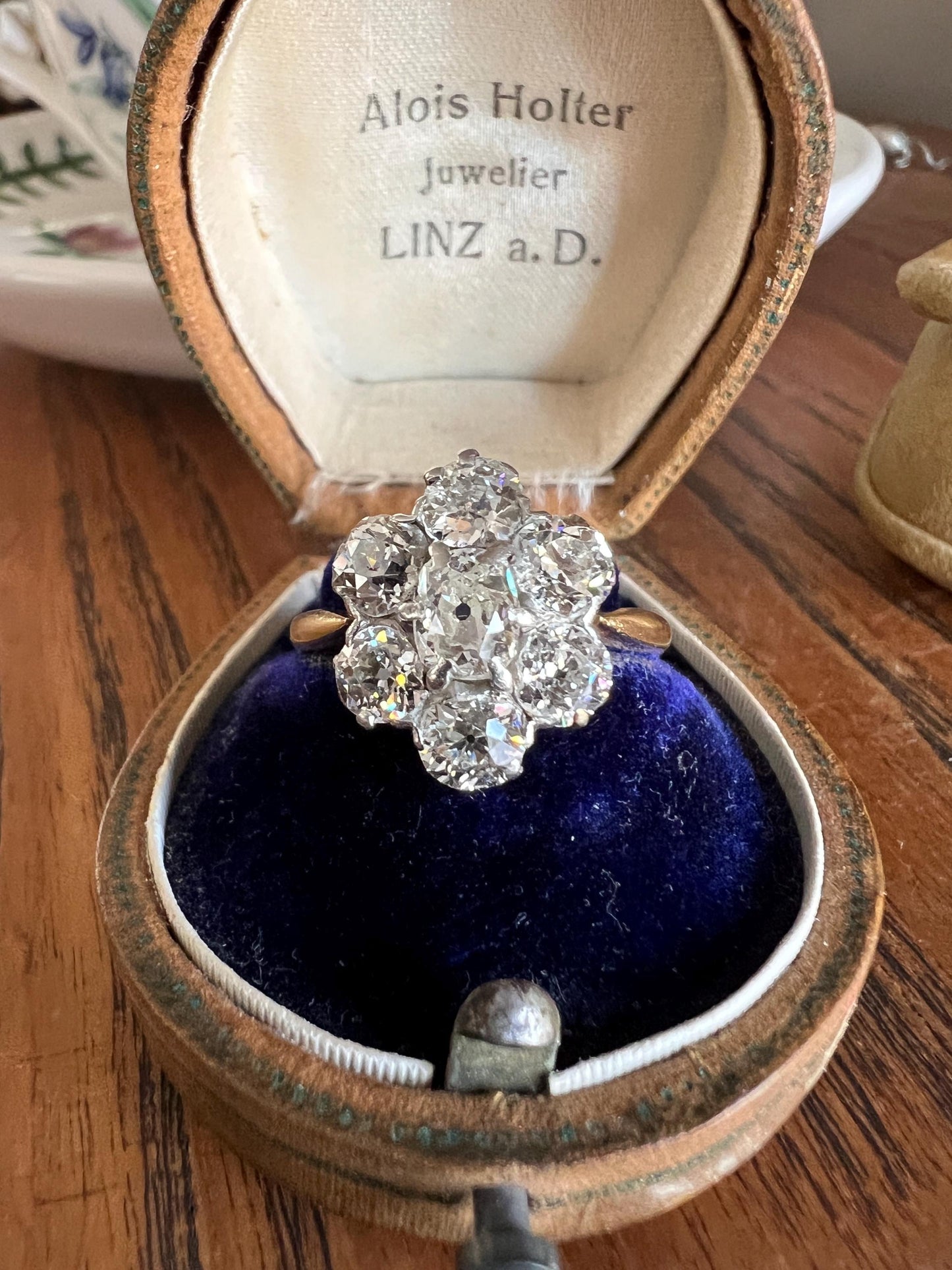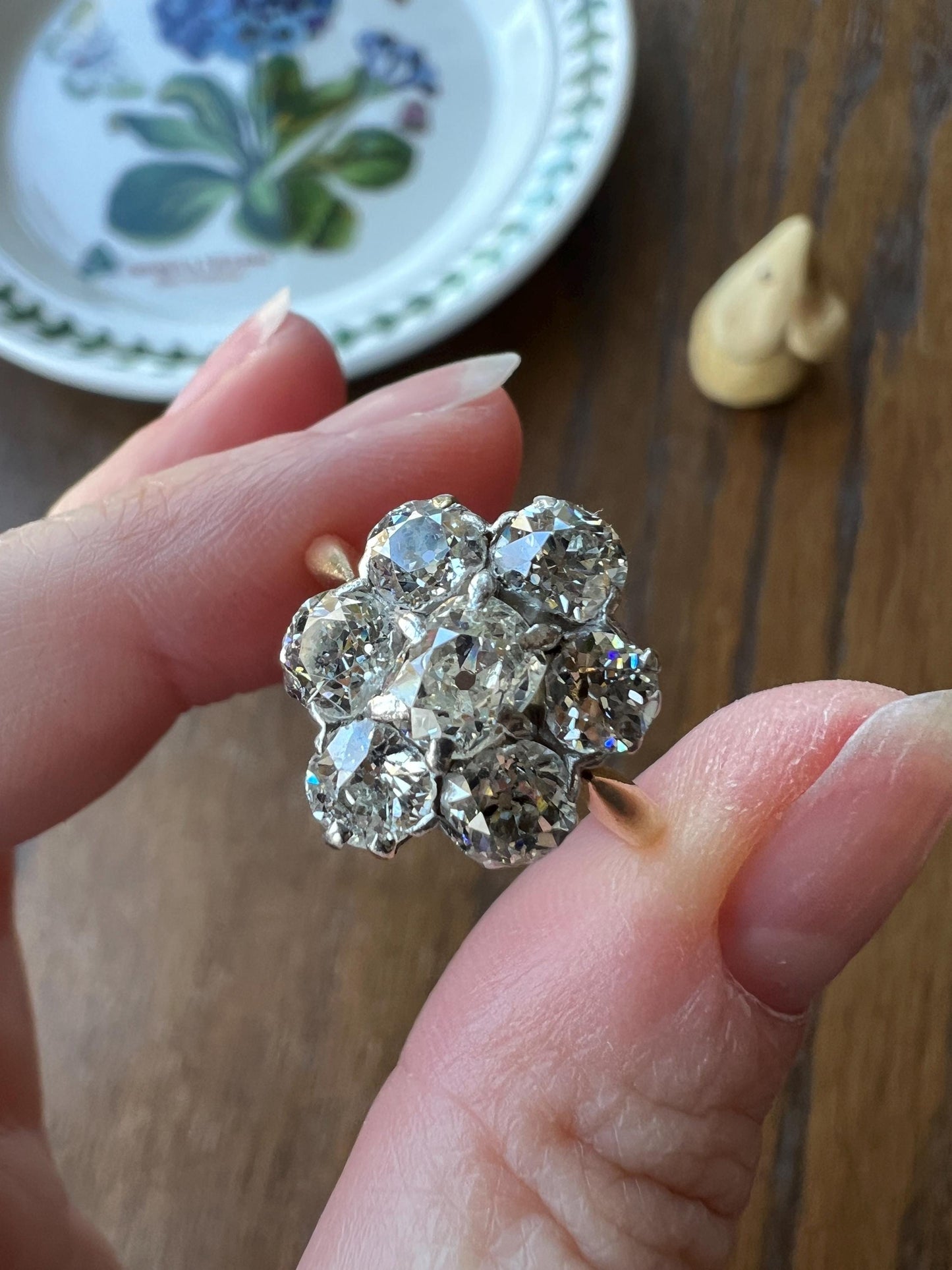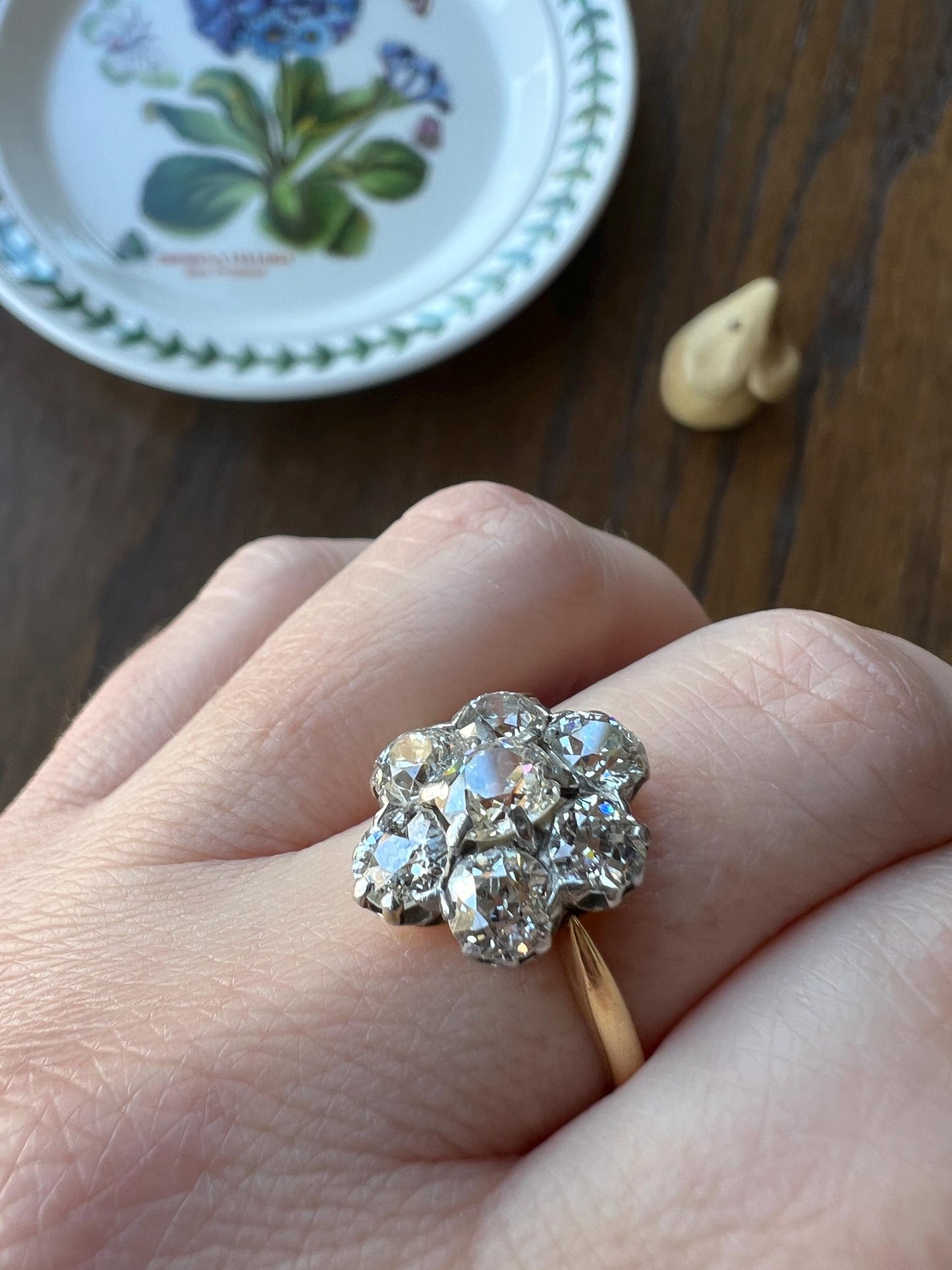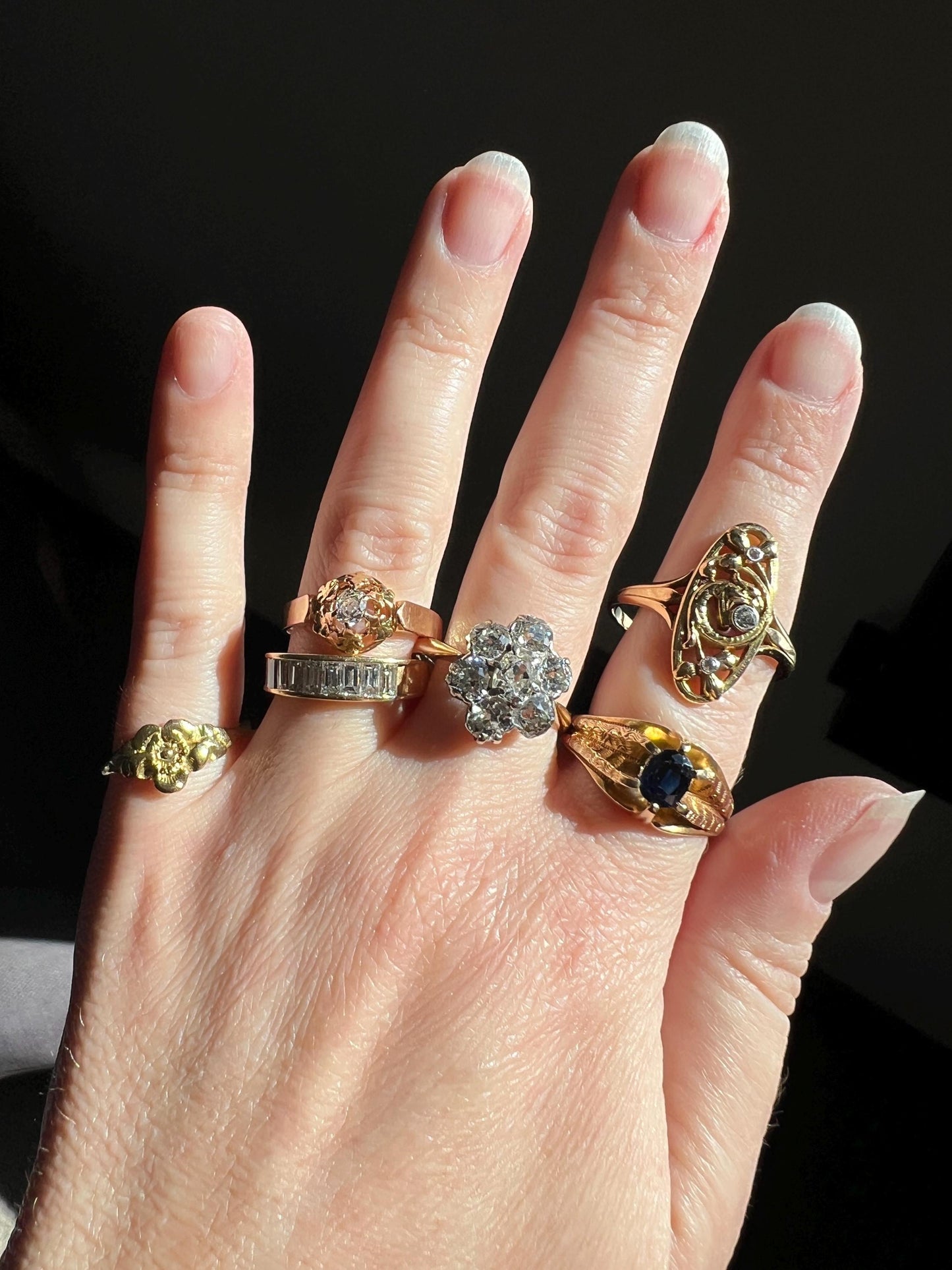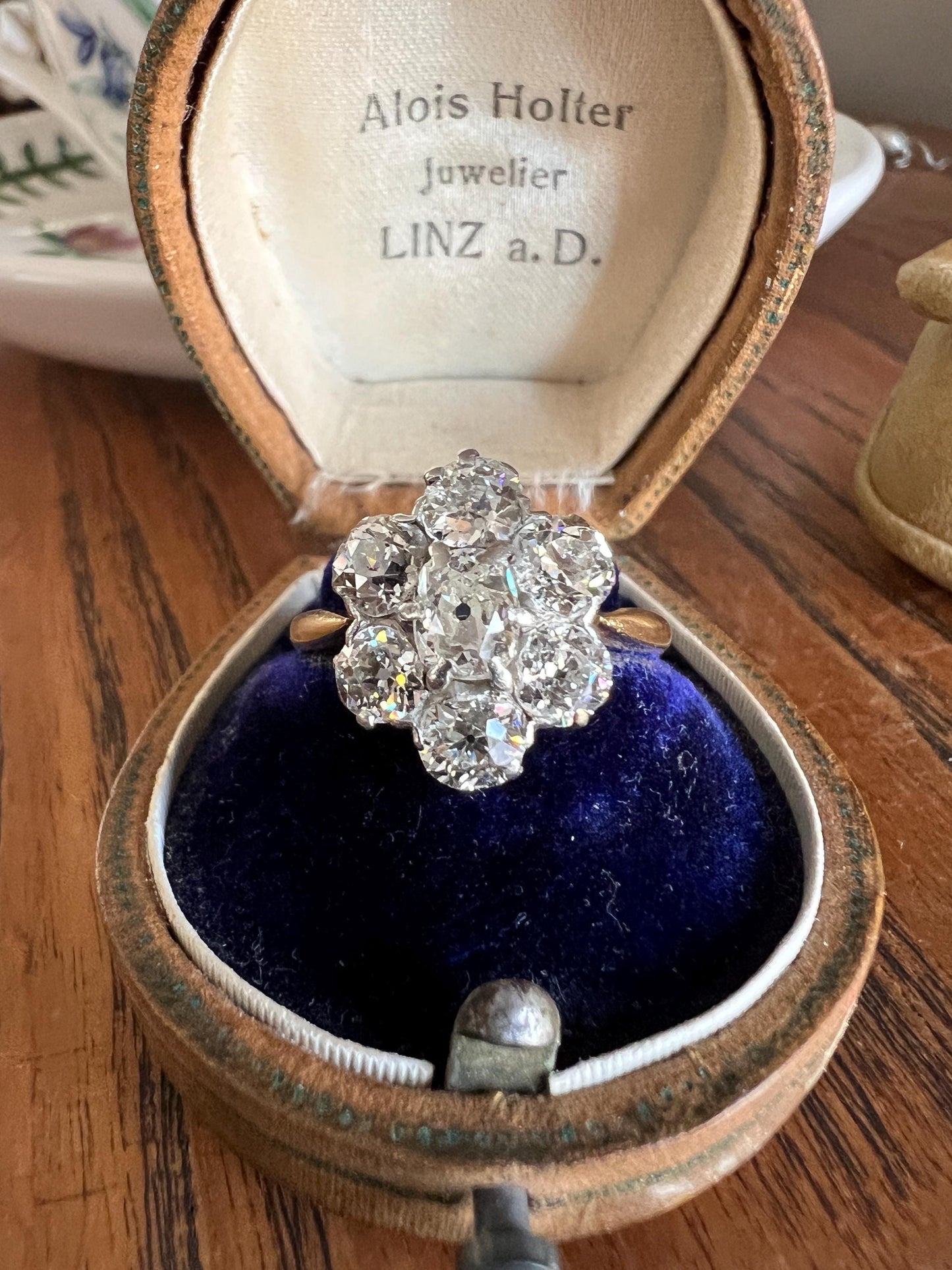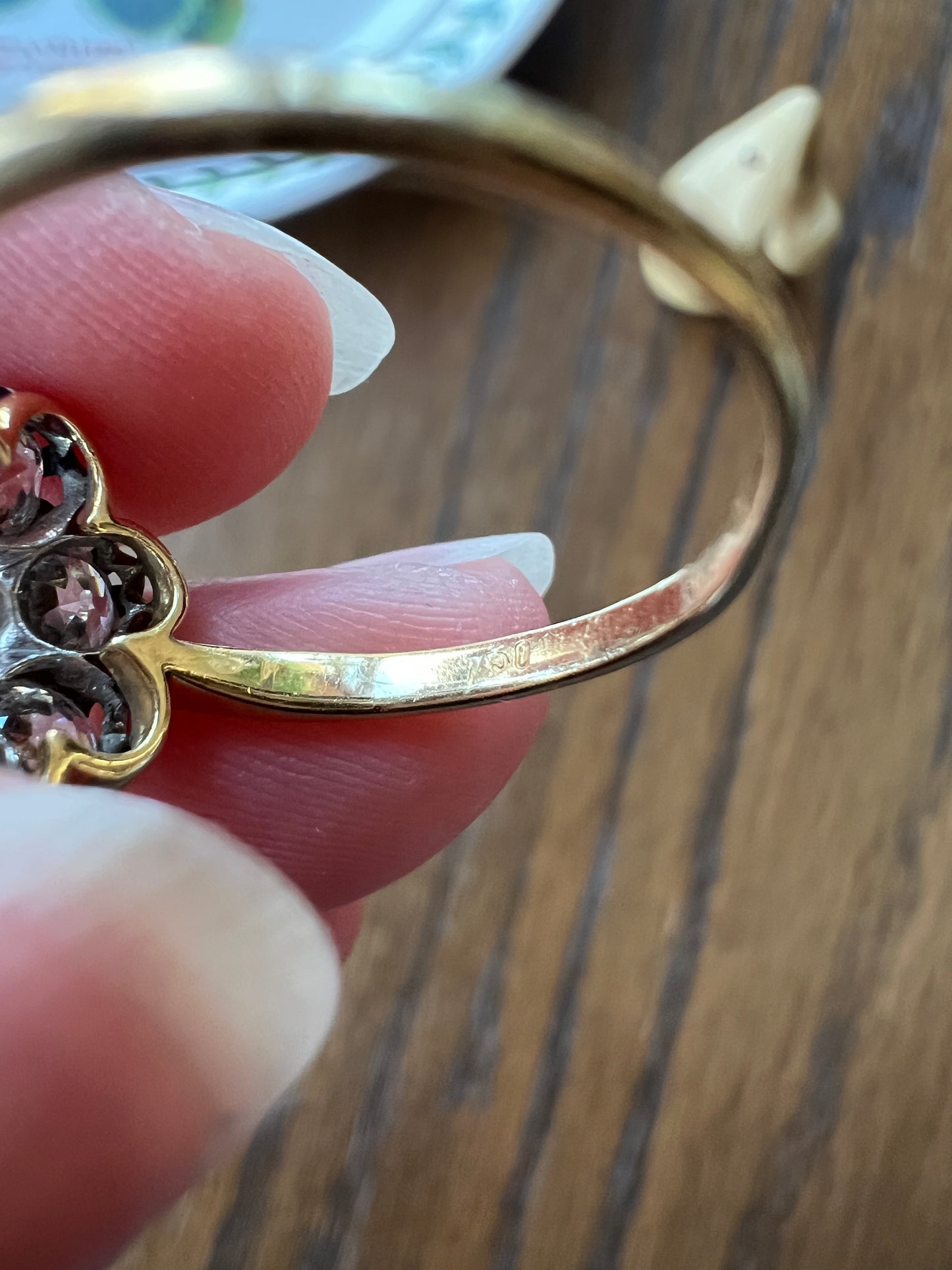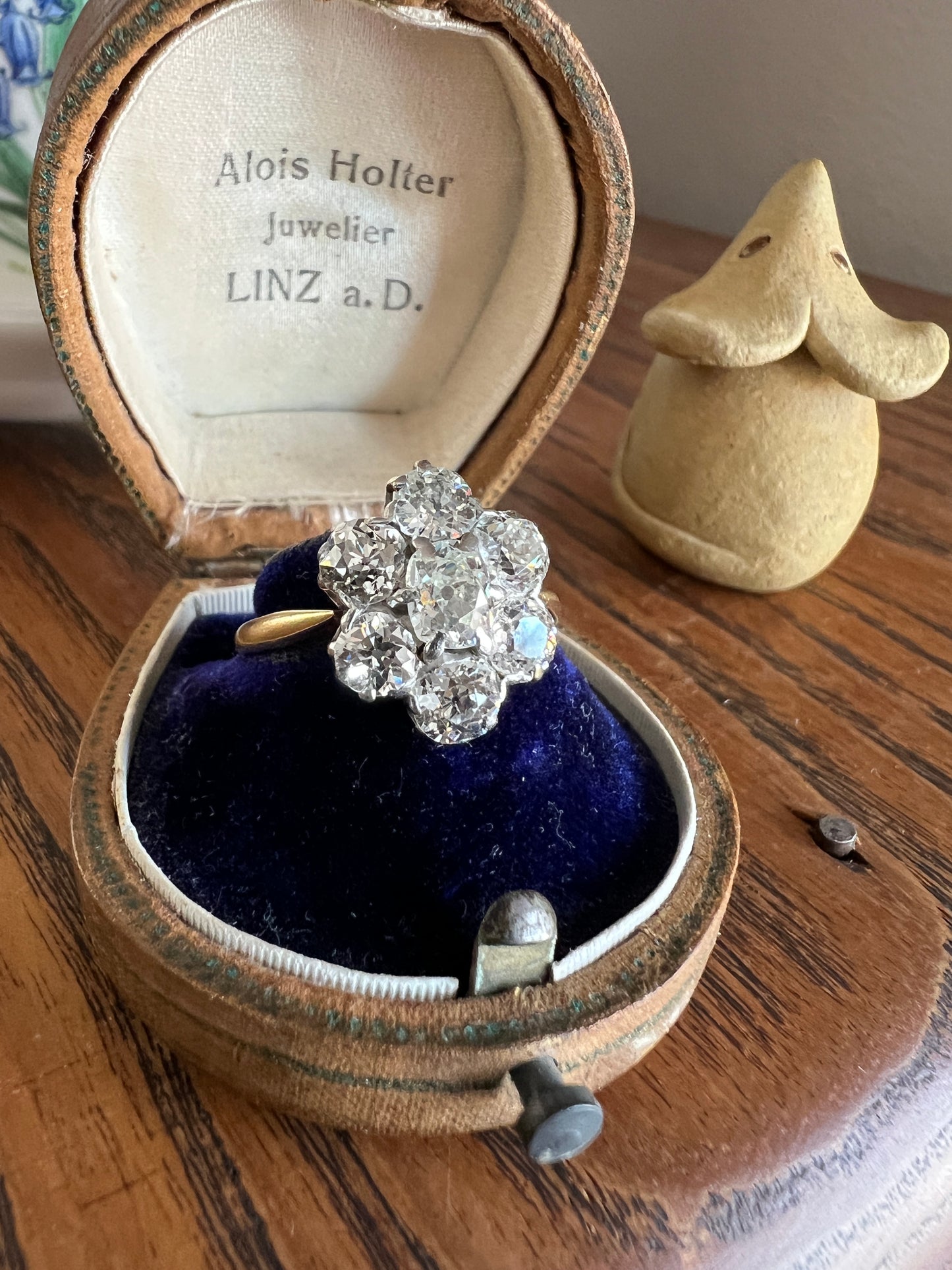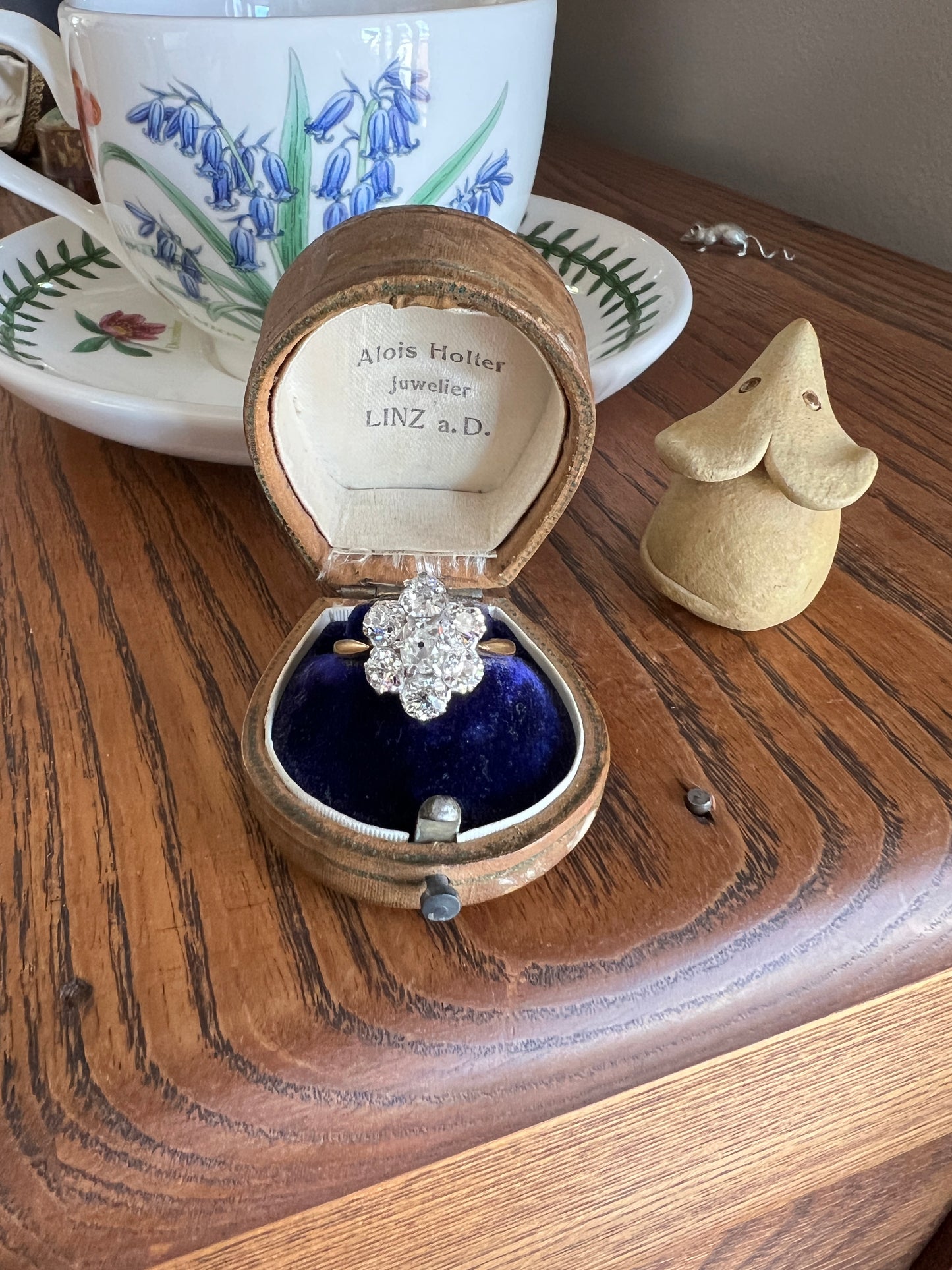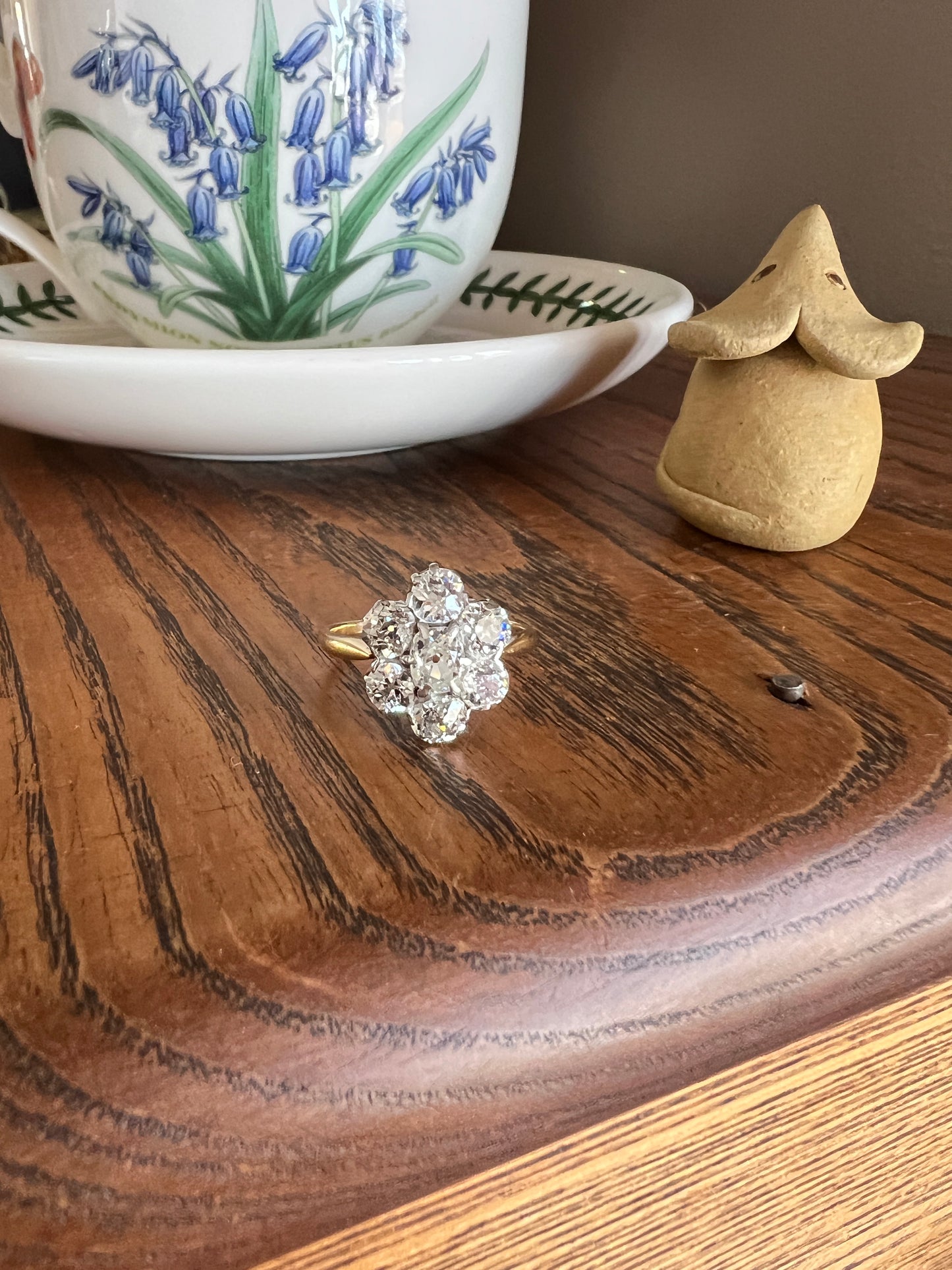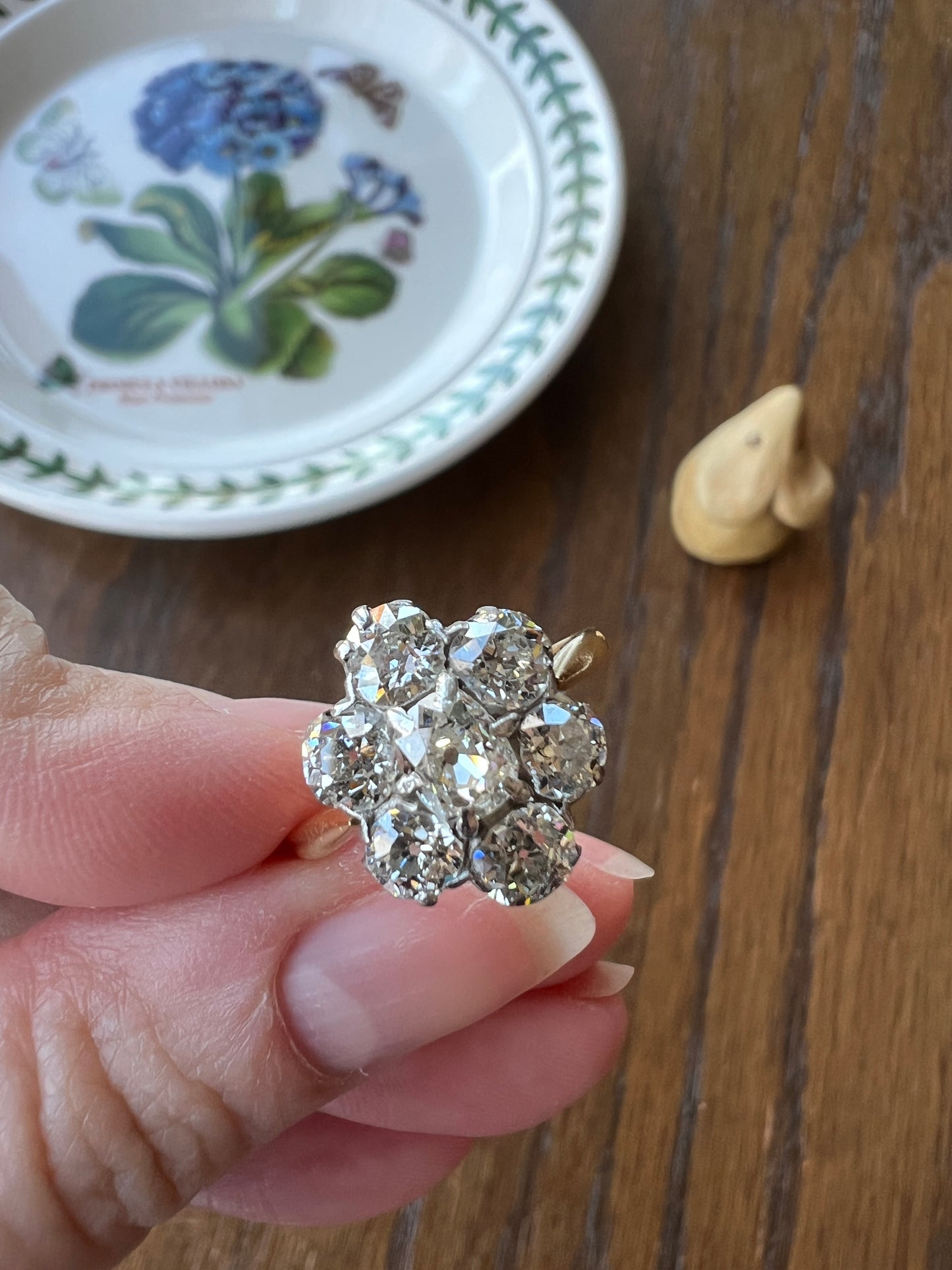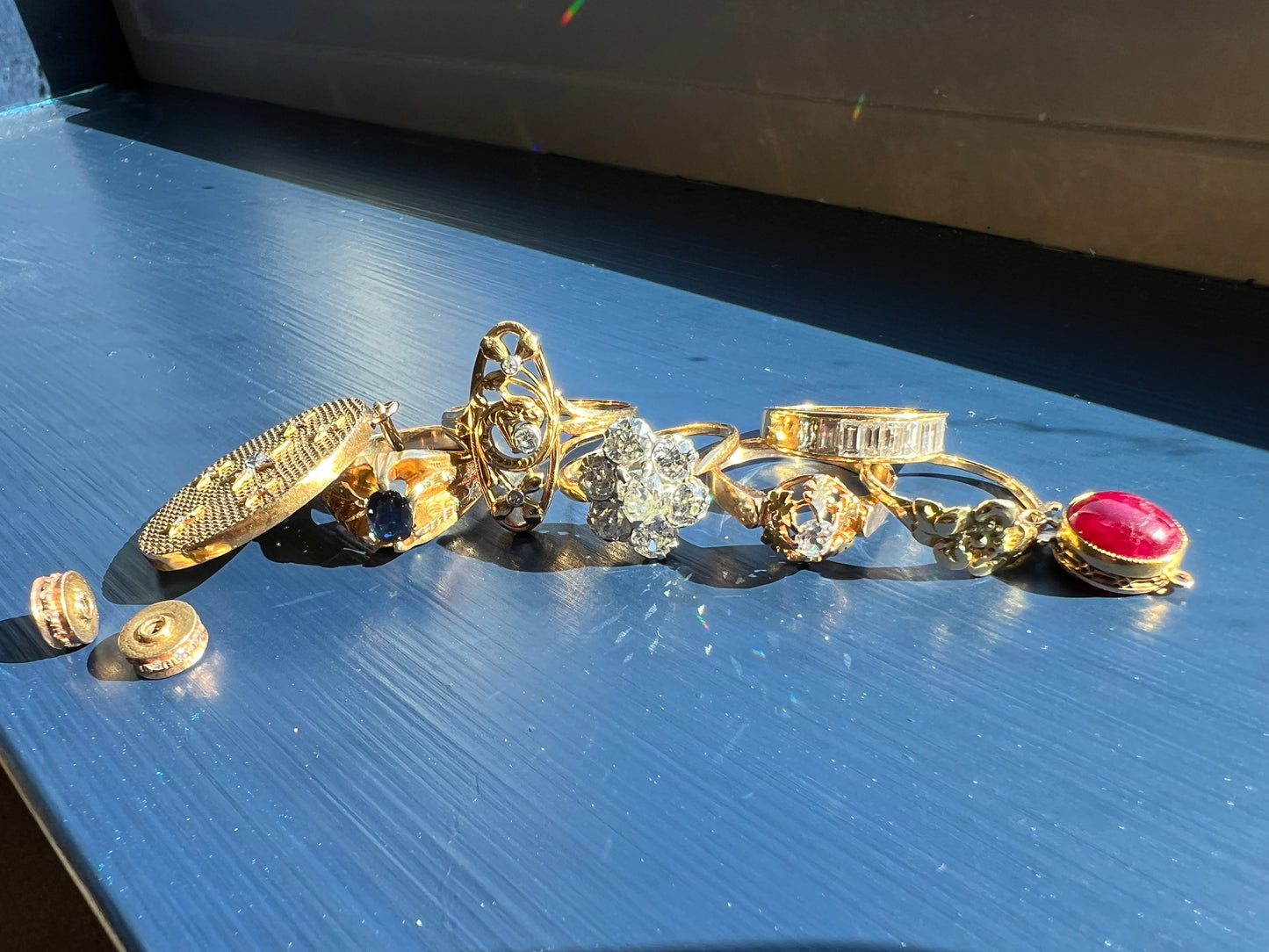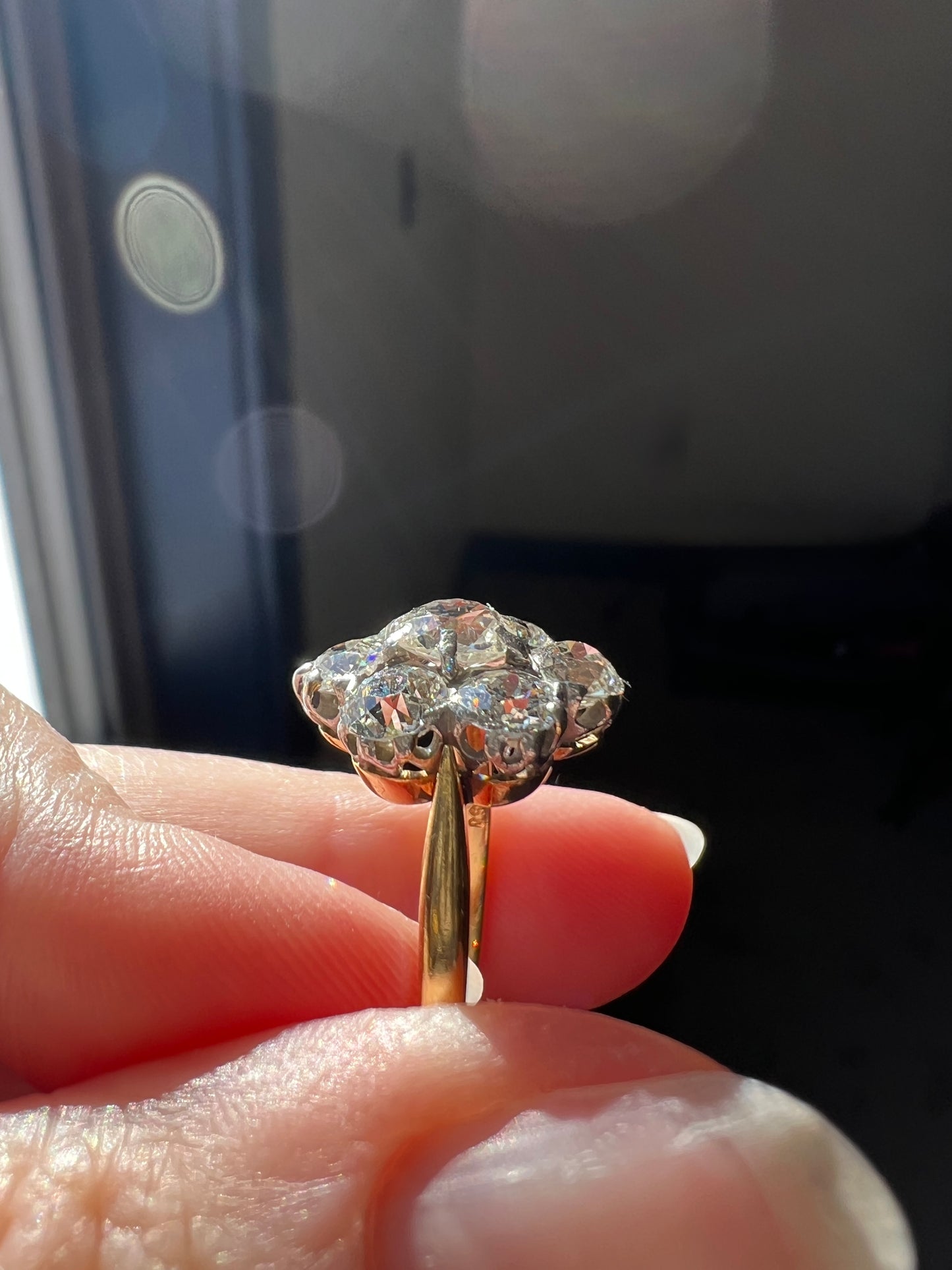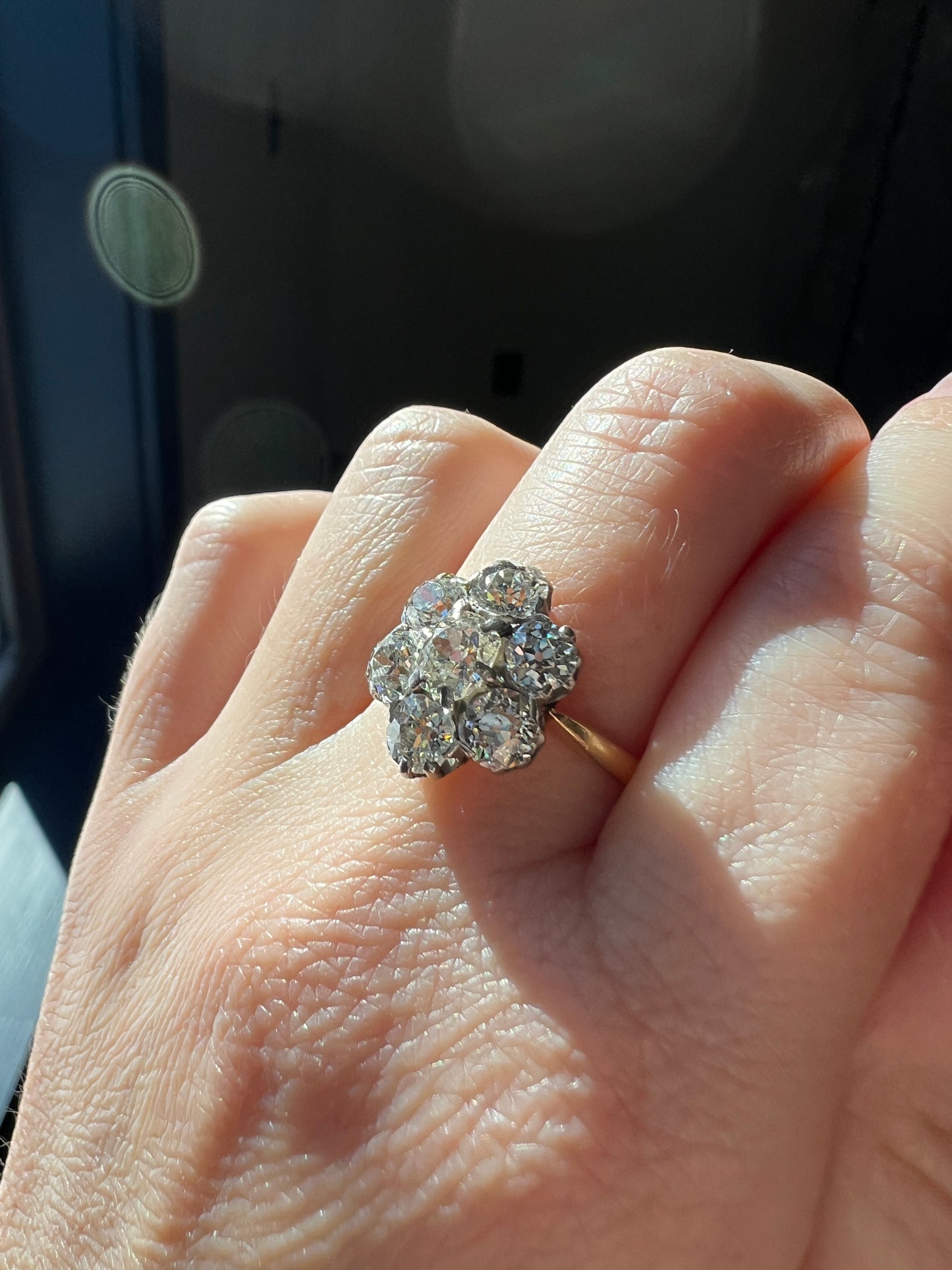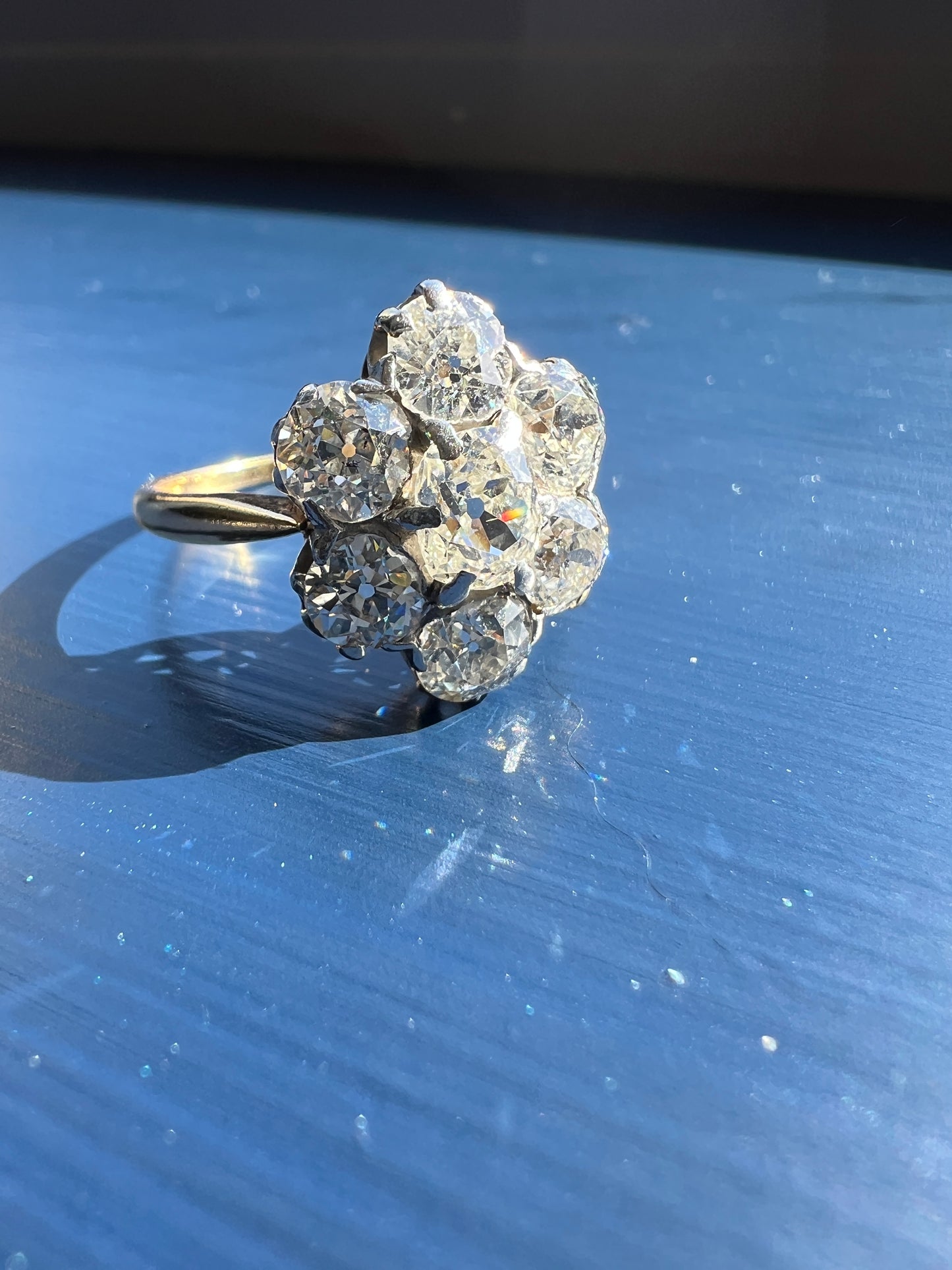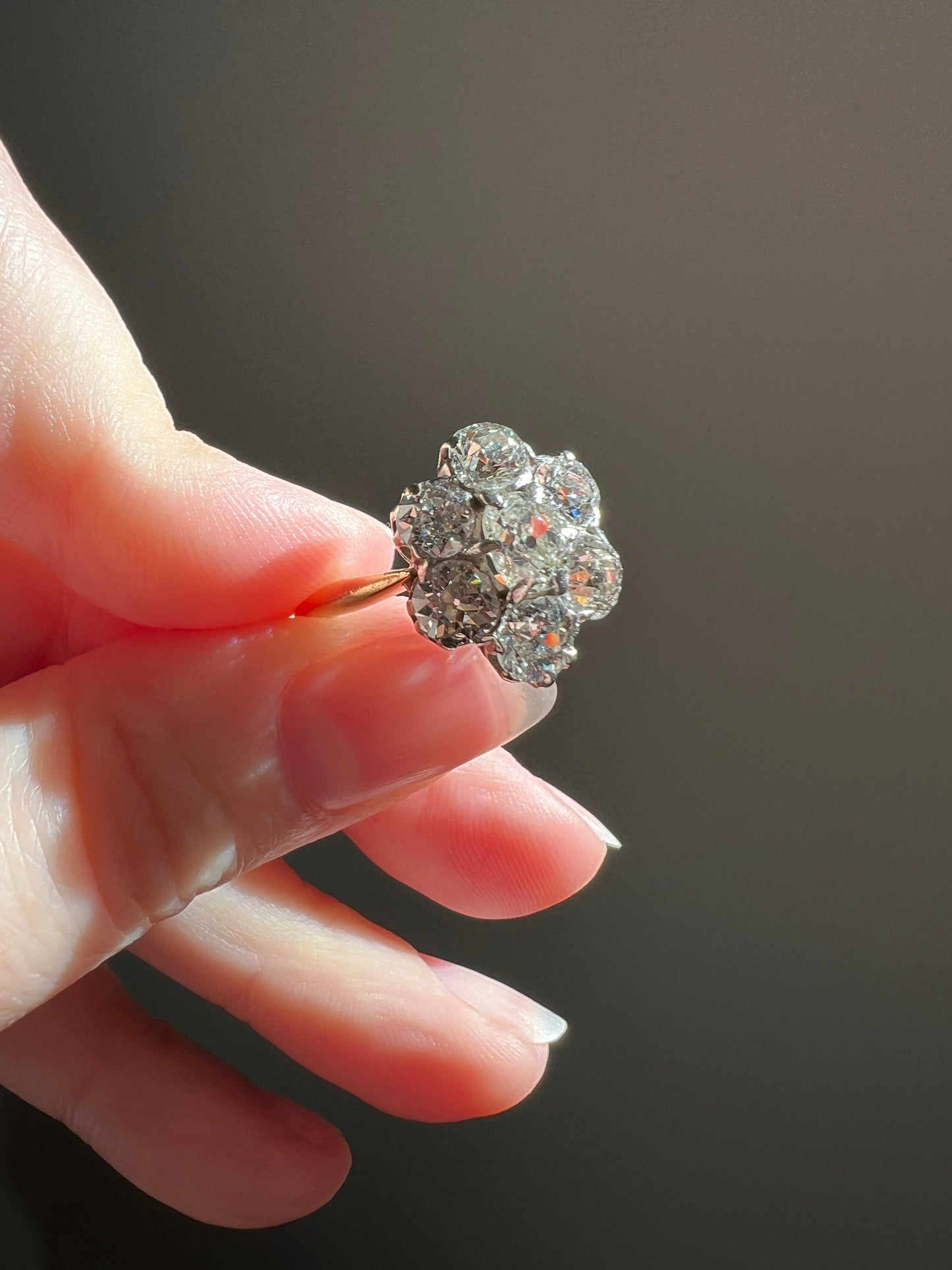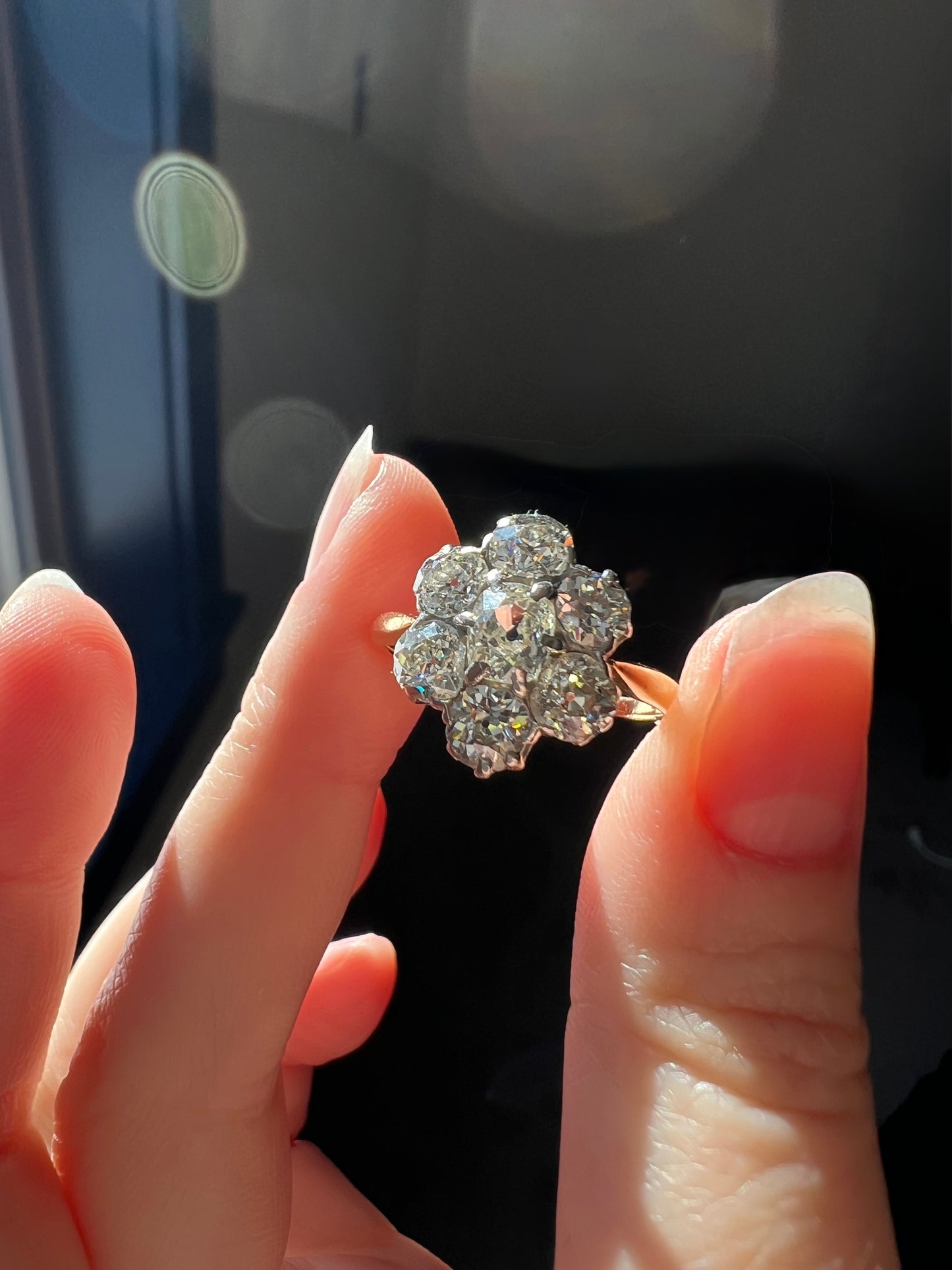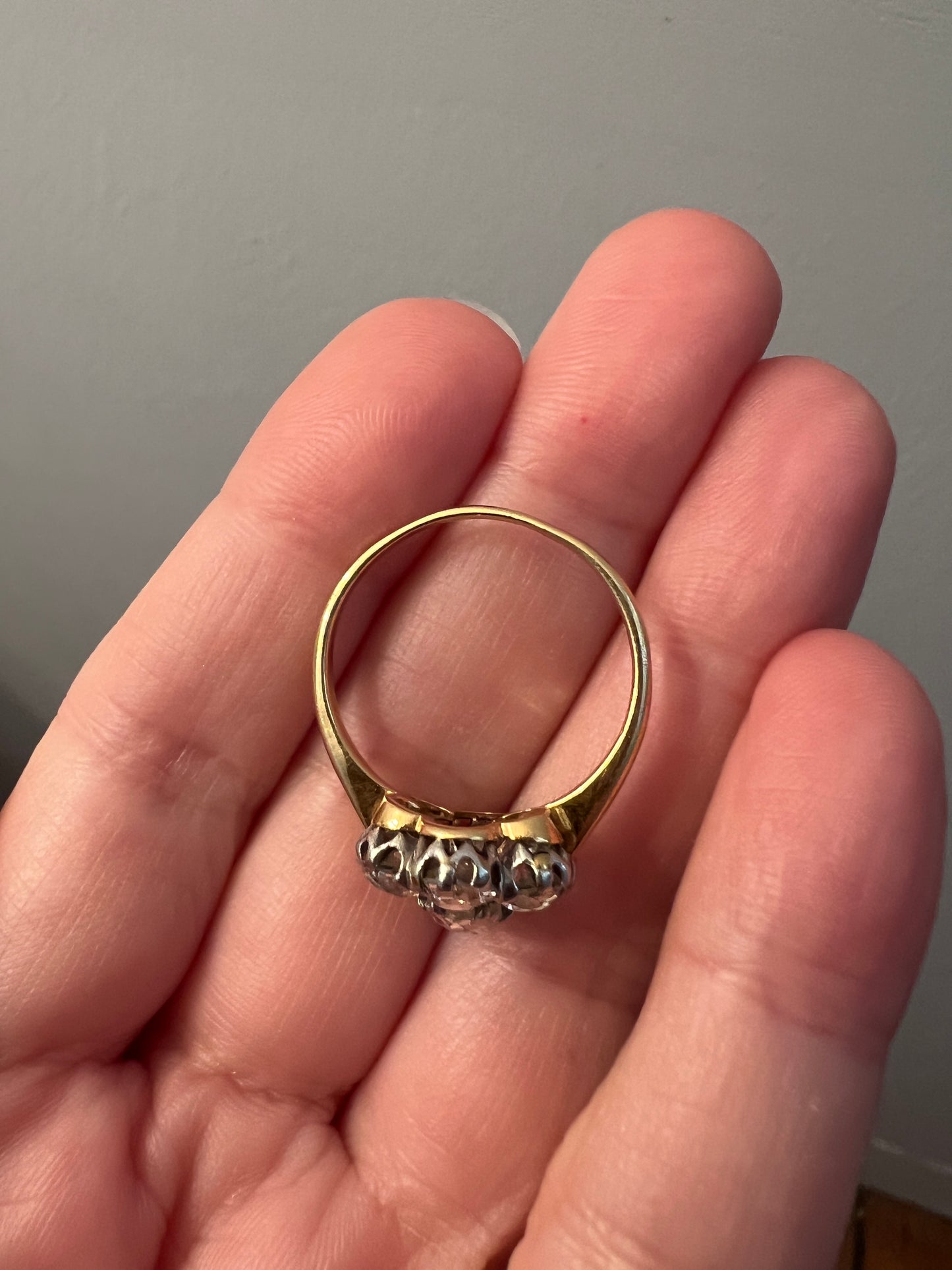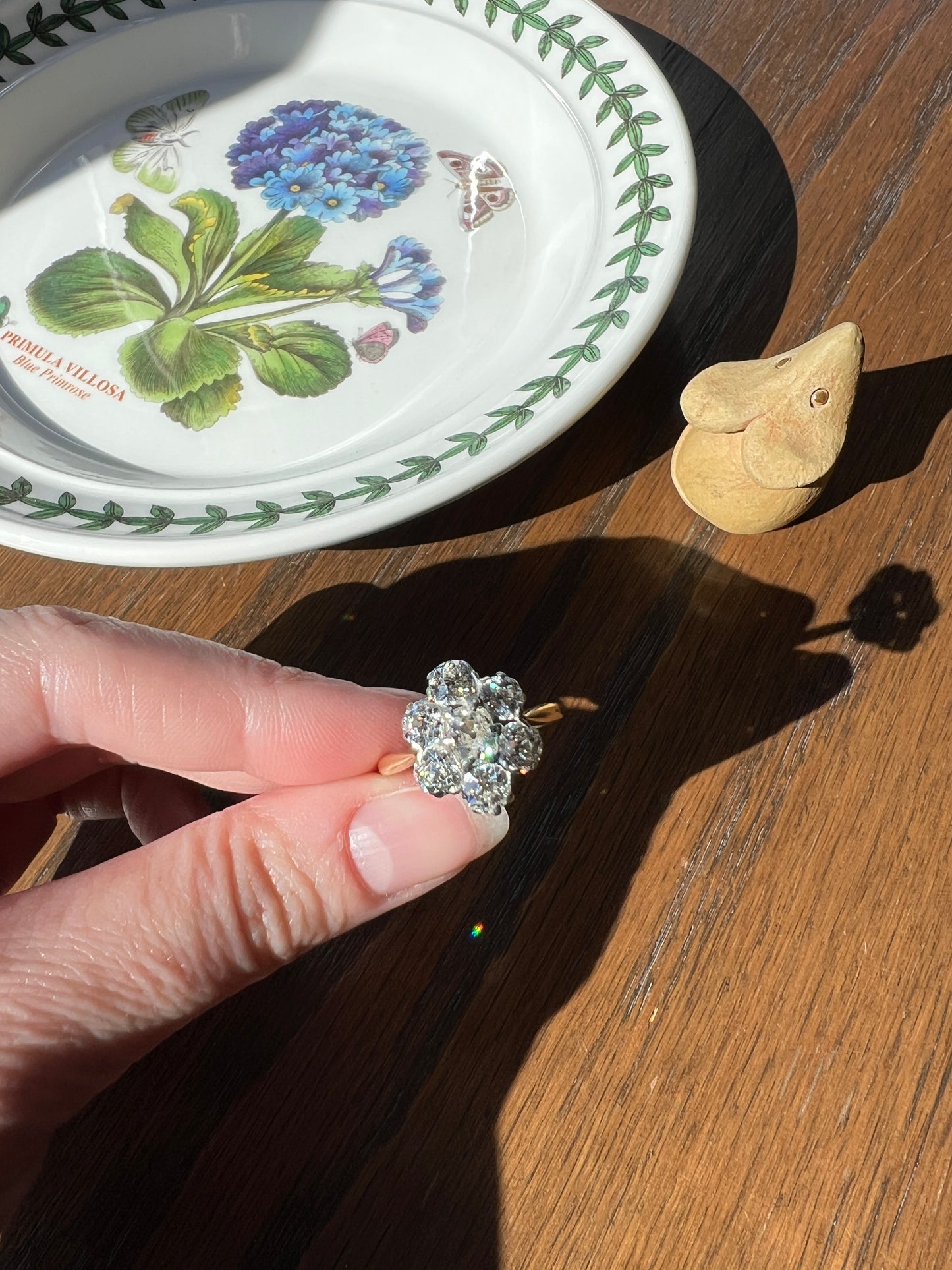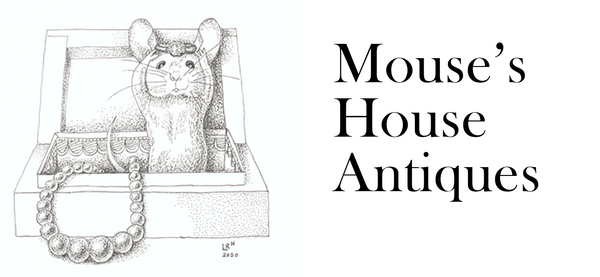Mouse's House Antiques
Antique OVAL 3 Carats Old Mine Cut DIAMOND Ring Scalloped Halo Daisy Cluster Stacker 3Ctw OmC
Antique OVAL 3 Carats Old Mine Cut DIAMOND Ring Scalloped Halo Daisy Cluster Stacker 3Ctw OmC
Couldn't load pickup availability
ABOUT:
I did the happy dance when I saw this ring. It's just so eye catching and sparkly with the three carats of antique diamonds including the elongated old mine cut at center and the scalloped halo of six additional old mines. Beautiful design and finger coverage.
It's alway fun to find antique hand cut diamonds in shapes other than round so the slightly raised in prongs, cushioned oval center is a great star of the show. The outlining diamonds are set in a scalloped setting, really putting the "daisy" in the daisy cluster setting. When often times the cluster ring face makes a circle, this one has a more interesting shape.
Found in France, the piece is crafted in 18k gold with their hallmark and an additional stamp inside of 750, which is the numerical hallmark used in Europe for 18k gold. The prongs are in platinum as was customary for the period to set diamonds in a white metal.
Timeless and wearable, a sought after classic.
Antique box not included. Please note the measurements as I have small fingers and it can be difficult to determine scale from pictures.
SIZE & MEASUREMENTS:
Size 8 1/4. The ring face is 15x13mm and stands 6.5mm off the finger to the raised center diamond. It weighs 4.4g.
Depths vary and I would not remove them from the setting to get exact measurements estimated 3 carats total weight in diamonds . The center diamond is about 5.5mmx5mm and about 0.6 carat alone, and the six diamonds in the halo are around 4.5mm each give or take each, measuring while set anywhere from .35 to .48 carat each.
IMPORTANT CONDITION NOTES:
All my pieces are pre-owned and in estate condition.
There are several worn prongs but the piece was re-tipped so that each stone has a full prong on each side. The center stone is not going anywhere and was fully reinforced on all six prongs. While I don't typically recommend daily wear for any of my 100+ year old pieces, this one is suitable as is for a bit more regular wear, with none of the stones moving and with the reinforcement that was already done. Despite some prongs being worn back, some completely, from what they originally were, the reinforcements were done where needed. I actually love this work - as it is a case where they did the minimal possible to add security to each of the settings, without over working it or making the piece like new. You will notice in the zoomed pictures that for this reason, the prongs are a bit uneven or not uniform from stone to stone, which I actually prefer over having every single tip with added length as it can actually make the ring face messy.
I love antique diamonds, even those with inclusions or hues typical for the time, because some of those were still among the best available in the market during that period, and were expertly cut by hand to enhance their best characteristics. So I don’t often like to compare antique stones against modern grading standards - BUT these have a nice fire and some of them are eye clean. So even though the ring was made long before the 4 C's existed, it sparkles really brightly and beautifully. Even as I look at it in ambient light now I am struck by its brightness - this coming from someone who looks at antique diamonds all day! It's a real head turner.
These are the typical antique diamonds with some faint natural inclusions. Most are just a frosty speck here or there seen mostly under magnification, the center stone has a few needles and two stones have the tiniest carbon specks. These are not visible to my eyes which are in their 40s, but may be slightly eye visible to the eagle eyed if being sought out. The largest center diamond has a slight warmth to it, typical for many antique stones which came from mines of the period that produced warmer rough stones for cutting, but it was expertly hand cut to face up brighter so that all stones are well matching. No chips or cracks, the center stone has a bit of an uneven girdle but this is not seen by the eye. A few tiny flea bites or a nibble seen only under magnification.
Please note that all my pieces are pre-owned and in estate condition. They will have patina, surface wear, a few small nicks. These pieces may also have evidence of a sizing, some build up around the stones and / or inclusions seen under magnification, typical for antique pieces. I have mentioned any noticeable issues above and they are all still wearable and eager to be loved and accepted for many years to come, (the preservation of antique jewelry, even those with signs of their age and history, is important to me. : )
But - Please note due to age, this piece is not in mint condition. Pictures also serve as part of the description and condition report so please utilize the zoom feature which will magnify any wear significantly more than what is visible to the eye while wearing : )
Thanks so much for looking at my items!
A note about antique diamonds:
The whole "4 C's" of cut, color, clarity, carat didn't come about until the 1940s so prior to that and especially on antique pieces, there was not as much emphasis placed on those things. (Sure people probably appreciated a certain look of a certain diamond as it appeared to the eye but it was not a graded scale like we have today.)
So it is difficult to judge antique stones against modern day diamonds and their grading system. No two old cuts are the same as they were crafted in times lacking any modern standards. The diamond cutters of the time were experts at hand cutting each stone to enhance it which means that even lower color grades can be cut to appear whiter.
It is also interesting that "lower graded" diamonds in today's scale system, were some of the best on the market during this period! So it is less about their grades and more about the unique play of light and color that each one can offer.
I read one article that put it nicely: “When searching for the perfect old cut diamond (for you), you need to view them through different eyes as you would for a modern diamond. Laboratory grading reports don’t offer too much information in regards to the individual beauty or sparkle of an antique diamond. Antique diamonds are judged more on the individual character and uniqueness that each one potentially offers.”
Often there are variations of diamonds in the same piece as the goldsmiths created pieces with the stones they had available to them.
Fun facts!
SOCIAL:
Please feel free watch @mouseshouseantiques on Instagram for inventory drops, sneak peaks and previews! And check out my website www.MousesHouseAntiques.com as I can add more pics there so you can get extra looks : )
All items hand picked by me, one at a time from all over the world. All listings individually written by me, and not AI, after studying each piece to discuss its beauties and its ; ) eccentricities (which I am picky to point out).
Box#st.#52
Share
